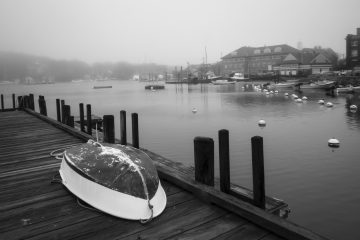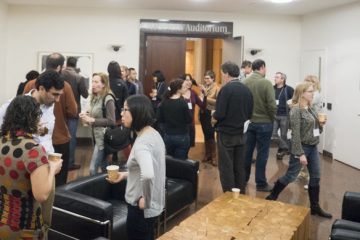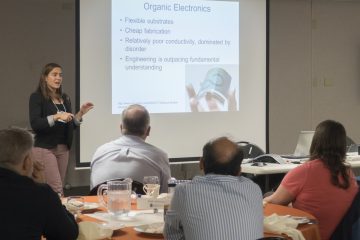The NESM 2015 “Spring” meeting was held March 5th at the Bruker Optics building in Billerica, MA, during which the Cape got a foot of snow. Meeting registration coincided with brief tours of demonstration/training lab spaces that house SEM-EDS-EBSD, AFM, stylus profilometer, optical emission spectroscopy, Raman and IR microscopy systems. The group of over 40 attendees enjoyed a buffet dinner before the two talks. Wendy Salmon, NESM President-elect, opened the meeting by thanking the hosts and reminding the audience that the Spring Symposium (the Woods Hole meeting) is coming up April 30 (tutorials) and May 1 (talks). Wendy also reminded everyone that the NESM board of directors has a turnover of 3 or more people every year, and that becoming a board member is a wonderfully social undertaking and certainly looks good on a CV. The first presentation, by Ali Bahadur and Robert Brandom (both of Bruker), presented the technology behind stand-alone x-ray computed tomography systems and SEM-based CT systems and showed many interesting examples of the types of virtual dissections and measurements that can be made from 3D CT reconstructions. We even learned we should eat more onions to increase our bone mass.
The second presentation was by Maria Kilfoil, Assistant Professor of Physics at UMass Amherst. She explained how her laboratory is using advanced light microscopy to look at budding yeast and in vitro biological materials of cellular cytoskeleton and mitotic spindle components to learn how forces coordinate spindle dynamics in living cells. By fluorescently tagging the pole of the mitotic spindle and/or the chromosomes in budding yeast, they can follow the movement of these structures as cells divide with high resolution fluorescence microscopy. In other experiments they are measuring microrheology of complex biological systems of cytoskeletal or nuclear components by using polystyrene beads as a read out of the viscoelastic nature of the complex network. They can also control the location of the beads with optical traps and measure the force generated by moving the bead in the biological network, or even squeeze a yeast cell between two beads.
Many thanks to our tour guides and to Bruker for hosting the meeting. We’re all looking forward to our next meeting at the Marine Biological Laboratory, in Woods Hole!



0 Comments